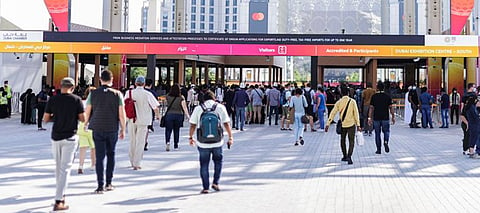
Meet the UAE signage company behind Dubai Exhibition Centre’s innovative digital visitor experience
Insights into the unique combination of digital and static wayfinding at DEC at Expo 2020
Dubai’s Blue Rhine Industries explains how the unique combination of digital and static wayfinding signage makes DEC at Expo 2020 the ultimate conference and events destination
Exit the metro into the central courtyard of Dubai Exhibition Centre (DEC) at Expo 2020 and you’re greeted by striking 12-metre-high digital totem signs, clad in the branding of the latest event taking place at Dubai’s newest conference venue.
Guiding visitors through DEC’s expansive 45,000 square metres of halls and meeting rooms is a hi-tech network of 1,600 digital and static wayfinding signage, all fully integrated into the venue’s state-of-the-art infrastructure. Behind this unique exhibition signage is Blue Rhine Industries, a Dubai-based digital display and signage manufacturer. Founded two decades ago in the emirate, Blue Rhine is a veteran of the Middle East’s booming technology and advertising scene.
Tasked with the installation and manufacturing of the signage, Blue Rhine collaborated with a range of contractor and design partners to bring the DEC vision to life. The wayfinding system, which combines digital and traditional signage, is the first of its kind in a venue of this size and Expo 2020 is the ideal platform to showcase its futuristic potential, says John V. Joseph, Blue Rhine’s Sales Director.
“As a homegrown UAE manufacturer, this project was unique, challenging and extremely rewarding to be part of. We built a wayfinding framework that creates a hyper-personalised visitor experience at an innovative global event in the city where Blue Rhine grew into the market leader it is today. At a traditional conference centre, you rely on roll-up stands or static lettering and bring in digital signage in the final stages, but this venue showcases how seamless and responsive the attendee journey can be when you integrate it from the beginning.”
Just one of 20 types of exhibition signage installed by Blue Rhine throughout DEC, the directional totem signs lining the North and South Complexes are split into static and digital halves. The illuminated static lettering on the bottom half directs visitors to fixed points of interest such as prayer rooms, and the top half is a water and dust-proof IP68 LED screen.
The combination of digital and static signage ensures that conference organisers can easily create their own visitor journey through DEC by adapting the content on display on the screen to their specific event. This can be controlled from a central content management system from anywhere in the world.
After entering DEC’s expansive North and South Complexes, visitors can use one of the available touch screens to download their delegate badge or scan a QR code with their smartphone to use an augmented reality event map. As they walk to the exhibition hall or meeting room, a sponsor’s marketing content can appear on the overhead video walls.
John explains, “With increasing reliance on personal devices, we see that there is more appetite for people to use these tools for navigation and accessing information in public spaces at points of interest. By integrating this into exhibition signage, brands not only tap into a creative, personalised way to reach target audiences, but organisers can also push out live public service information. You could display AR or virtual reality advertisements, stream sessions, or issue live health and safety announcements in response to what is happening on the ground. For example, if there’s a fire, you could direct people to emergency exits.”
In keeping with DEC’s entire look and feel, the shape of the 12-metre totems is inspired by the UAE’s sand dunes. Blue Rhine manufactured and installed custom LED screens to fit the required curved design.
Optimised for low energy consumption
Nimesh Nair, Deputy Manager of Projects at Blue Rhine, says that the screens had to be fully colour-calibrated and programmed for different brightness levels so that Expo 2020 visitors can get the optimal experience. For such high-resolution and bright LED displays, it would be easy to assume the screens are expensive to run, but Nimesh explains this isn’t the case.
“Our IP68 screens require 40 per cent less power than traditional equivalents. Due to how advanced the technology is, we can produce a high-resolution screen and reduce the power supply without impacting the display quality.”
Nimesh adds, “To ensure structural integrity, we engineered all metalwork so that the signs stay completely stable, cladding them in a special grade of stainless steel so they also keep their pristine appearance. We manufactured and installed all screens according to scope and on time with the expectation that Expo 2020 would begin in October 2020.”
Blue Rhine was also awarded one of the highest scores for health and safety on site. “We were already compliant with Expo 2020’s stringent worker welfare requirements before the project began, which is a highly advantageous position for a sub-contractor working in a dynamic, competitive market such as Dubai,” John explains.
With DEC now hosting global events at the heart of Expo 2020, Blue Rhine has embarked on its newest venture by branching out into AR and VR brand experiences and dynamic content creation with the launch of Waai Tek, the company’s artificial intelligence arm.
“Through Waai Tek, we are using our technical understanding of signage hardware to help brands leverage the digital solutions at their fingertips in the most engaging way possible,” says John. “With the rise of the metaverse and combined realities in everyday life, we believe this is the future of our industry.”
Learn more about Blue Rhine’s work at Expo 2020 here.
This content comes from Reach by Gulf News, which is the branded content team of GN Media.
